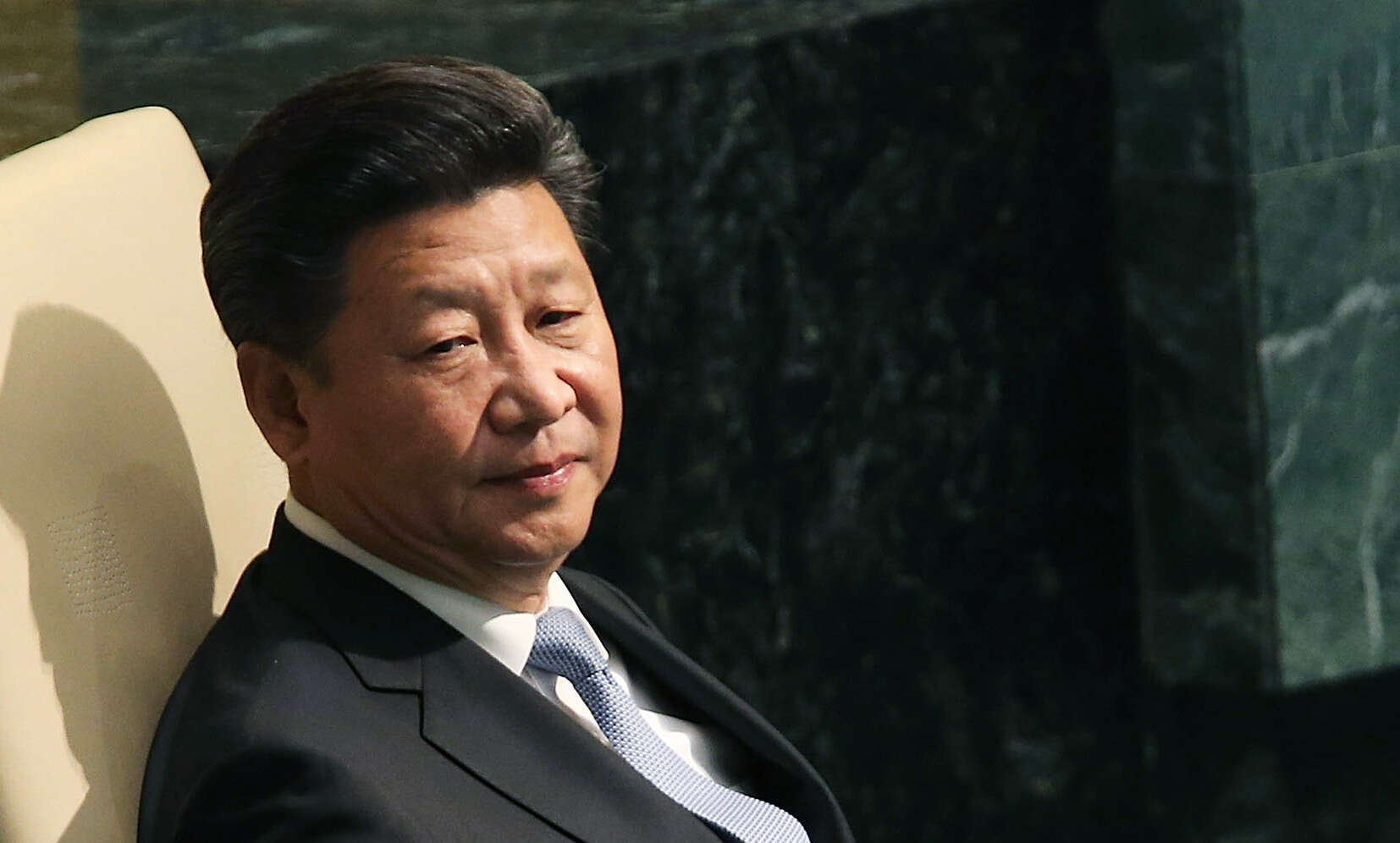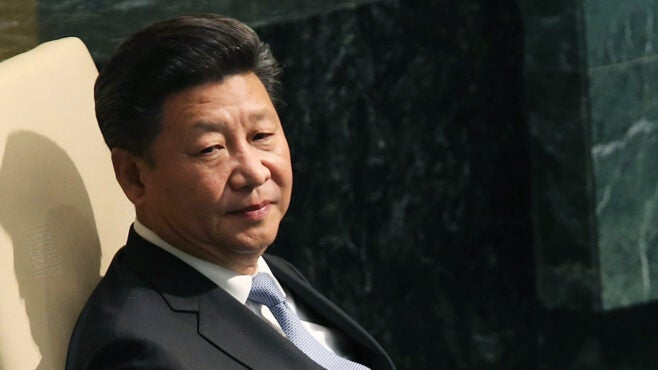

President Xi Jinping’s 21 September pledge may have had a knock-on effect on other countries’ coal-financing plans. (Photo by Spencer Platt/Getty Images)
- President Xi Jinping’s September announcement that China would build no more new coal-fired plants overseas was welcome, but more action is needed.
- China generates twice as much power from coal domestically as its coal plants abroad, and Japanese and Western banks lend the most to the sector.
- Environmental groups say many China-backed projects already in planning or construction appear to still be going ahead.
The new coal policy that HSBC announced on 15 December was met with derision by climate campaigners. ShareAction pointed to “a number of disappointing loopholes”, while Market Forces called it “a dismal, missed opportunity for real climate action”. The broad consensus is that the British bank’s move is better than nothing – and a testament to the power of shareholder engagement – but far from enough.
HSBC said it would phase out thermal coal financing in EU and OECD countries by 2030 and globally by 2040. Non-governmental organisations (NGOs) see this as kicking the can down the road by failing to introduce meaningful restrictions for years.
Even so, the announcement makes HSBC the latest institution to toughen its stance on the dirtiest fossil fuel in use today.
One of the most celebrated – and to many, most consequential – such commitments came from Chinese president Xi Jinping’s speech at the UN general assembly on 21 September. Buried in the translated version were 24 words that pleasantly surprised many: “China will step up support for other developing countries in developing green and low-carbon energy, and will not build new coal-fired power projects abroad.”
The statement appears hugely significant, given that China is the biggest public financier of overseas coal plants, but it was low on detail, leaving many sceptical about the likely outcome.
Potential impact
Still, it could affect 44 coal plants earmarked for Chinese state financing, with a deal value totalling $50bn, according to US think tank Global Energy Monitor.
Moreover, it seems there have already been knock-on impacts. Just three days after Xi’s statement, Bank of China, the sixth-biggest lender to the coal industry globally (see table below), said that from October 2021 it would not finance new coal mine projects abroad. Hinting at what was to come, domestic rival ICBC had in June begun phasing out financing for the commodity. The government has sizeable stakes in both institutions.
In addition, in the run-up to and during Cop26 several other countries announced a phase-out of coal. Major producers and users Indonesia, Korea and Vietnam joined the Powering Past Coal Alliance – although Indonesia declined to sign the most important clause, which addresses the issuance of new permits. There is a sense that these countries – historically major recipients of Chinese funding for coal projects – may well have been emboldened by Xi’s commitment. And in October, OECD countries agreed to end export credit support for new coal plants.
For [Xi's] announcement to have the biggest impact, it would need to apply to both capital participation and construction arrangements. Ma Xinyue, Boston University’s Global Development Policy Center
“Almost all major international public coal financiers have now committed to stopping building coal power plants overseas, and that is a big step,” says Ma Xinyue, China research lead at Boston University’s Global Development Policy Center. “On the other hand, there is no collective goal for abating coal. And even though many private companies have made net-zero plans, it’s still at a voluntary level, and we will have to see how closely they abide by their commitments.”
Governments could do much more in regulatory terms to push for transparency and accountability for both public and private actors, Ma tells Capital Monitor.
While coal was a key Cop26 focus for the UK government, summit president Alok Sharma and his team ultimately failed to persuade 195 other governments to commit to ending all new financing of the commodity. Instead, after heated negotiations that ran well over time, they got a commitment to ‘phase down’ coal use into the final agreement.
Some progress is being made on this front. Between 2017 and 2021, four-and-a-half times as much overseas coal capacity linked to China was cancelled as was constructed, according to the Centre for Research on Energy and Clean Air in Helsinki (see graph below). But environmental groups say things are not going fast enough.
China: Coal’s biggest backer
Data on China’s overseas coal funding is widely viewed as unreliable, but anecdotal evidence suggests the country’s banks are the lenders of last resort for coal projects globally, as Western banks introduce new policies for lending to the industry.
Certain data backs that up. China is financing 75 of the 100 planned coal plants globally, according to Global Energy Monitor. And, if coal lending and underwriting are combined, Chinese banks are the biggest players in this space, says campaign group Rainforest Action Network (see table below).
They underwrite 58% of all loans to coal companies, although they account for just 6% of total lending, shows research published by environmental non-profit organisation Urgewald in February. Most loans are provided by Japanese and Western banks (see table above), which are also under pressure to tighten their lending criteria. (Barclays, BNP Paribas and MUFG stress that Urgewald collected this data before they made their net-zero commitments or updated their coal lending policies.)
China is also the biggest public financier of foreign coal plants, accounting for 50% of all public finance commitments between 2013 and 2018, says the Boston University Global Development Policy Center. But 87% of the total public and private funding for overseas coal plants comes from non-Chinese entities, it adds.
Indeed, banks’ coal financing globally was 25% higher last year than in 2016, says Rainforest Action Network.
That’s not to mention capital flows from other investors. Capital Monitor analysis in August found that, despite a tidal wave of net-zero emission pledges, major asset managers’ exposure to coal companies had grown marginally since 2020. Almost half of the world’s biggest 29 fund houses by assets do not have a coal policy in place.
So it is hardly surprising perhaps that the International Energy Agency said in April this year that global coal demand would rise by 4.5% in 2021 – in large part due to China. That sent the price soaring fourfold on the previous year to a high of $170 per tonne, providing a further incentive to invest in the industry.
Where to draw the line
Certainly, China-backed overseas projects in the planning, permitting and construction phase seem to be continuing, as environmental groups believe is the case. Research by Copenhagen-based NGO Just Finance International suggests many such developments in Bosnia, Indonesia, the Philippines and Serbia appear to still be going ahead.
But that is to be expected, says Harry Broadman, Washington, DC-based chair of the emerging markets practice at consultancy Berkeley Research Group. “Every word in the [Xi’s] statement will have been chosen incredibly carefully – for instance, the word ‘new’ is a very important adjective. If we’re taking him at his word, there is no reason why anyone should be surprised or upset that existing projects are continuing to be financed.”
For the announcement to have the biggest impact, it would need to apply to both capital participation and construction arrangements, Ma says. If that is the case – and if projects already under construction were cancelled – 594 milllion tonnes of carbon emissions, more than Canada’s annual CO2 output, could be avoided.
But if the announcement only applies to projects announced from September 2021 onwards, it will have “very few climate-saving impacts because negotiation and implementation of any agreement for coal takes years” and the average coal-fired power plant operates for at least 40 years, says Wang Wawa, programme director at Just Finance International.

Lauri Myllyvirta of the Centre for Research on Energy and Clean Air says a spree of power purchase agreements for coal plants have been signed in Indonesia. (Photo courtesy of CREA)
Lauri Myllyvirta, lead analyst at the Centre for Research on Energy and Clean Air, adds: “If only the paper work has been signed, then that stuff can’t continue, but with any big announcement like this, you have to draw the line somewhere. If a project is weeks or months away from completion, you’re not just going to tell everyone to forget about it and fly home.
“Where there could be room for negotiation is where contracts have been signed and nothing else [has happened],” he says. “But getting out of commercial contracts is hairy for understandable reasons.”
Indonesia is a key location for such situations, as the country is already at coal capacity and at Cop26 indicated plans to phase out coal, Myllyvirta says. “Yet they have been on a spree of signing power purchase agreements [for new coal plants] – that is economic insanity, not to mention the climate impact [it would have].”
China's domestic coal sector
The other, rather larger, elephant in the room is China’s domestic coal industry, which accounts for 70% of the country’s power generation. Beijing has said it will look to gradually phase coal out from 2026 onwards, but until then the sector is free to grow. That is a big deal, given that China is by far the world’s biggest fossil fuel CO2 emitter and consumer of coal. The country’s overseas coal plants produce 42GW of electricity a year; domestically it generates at least double that.
On the other hand, China has also introduced some of the most progressive policies in Asia, including a green bond taxonomy of sorts in 2015 and, just this year, an emissions trading scheme.
A widely held concern is that these moves, like Xi’s pledge on overseas coal, are symbolic window dressing that will not move the needle nearly fast enough on carbon emissions reduction.
The devil will likely, as ever, be in the detail – of which there is very little so far.






